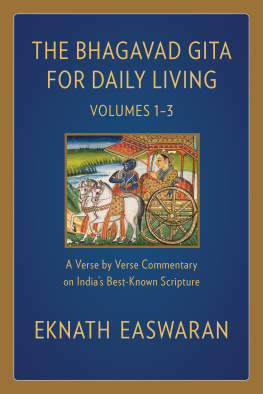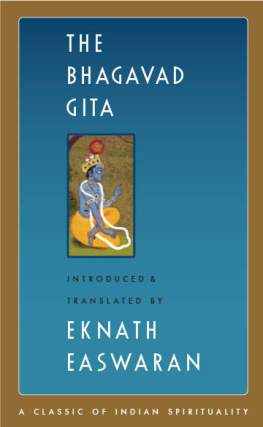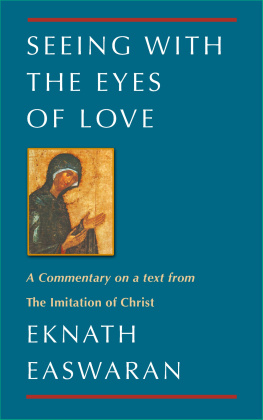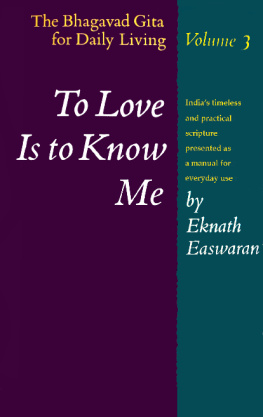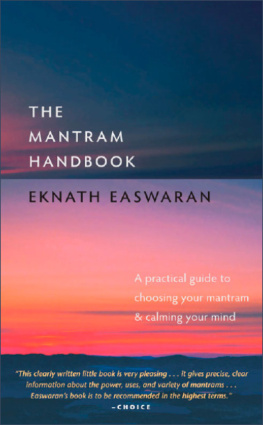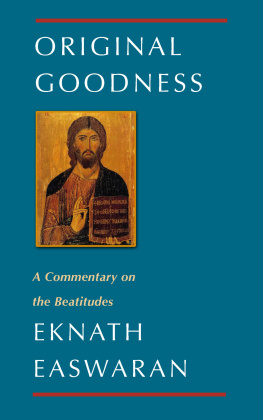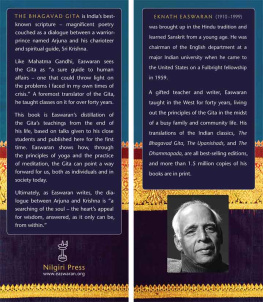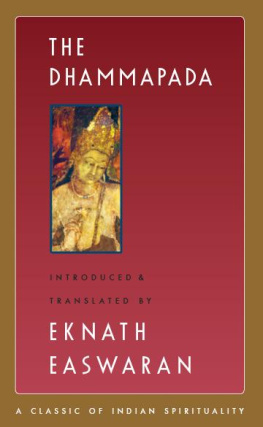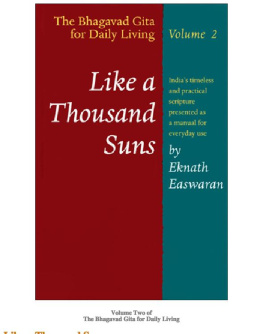Eknath Easwaran - The Bhagavad Gita for Daily Living Vols 1 to 3
Here you can read online Eknath Easwaran - The Bhagavad Gita for Daily Living Vols 1 to 3 full text of the book (entire story) in english for free. Download pdf and epub, get meaning, cover and reviews about this ebook. year: 2020, publisher: Nilgiri Press, genre: Religion. Description of the work, (preface) as well as reviews are available. Best literature library LitArk.com created for fans of good reading and offers a wide selection of genres:
Romance novel
Science fiction
Adventure
Detective
Science
History
Home and family
Prose
Art
Politics
Computer
Non-fiction
Religion
Business
Children
Humor
Choose a favorite category and find really read worthwhile books. Enjoy immersion in the world of imagination, feel the emotions of the characters or learn something new for yourself, make an fascinating discovery.
- Book:The Bhagavad Gita for Daily Living Vols 1 to 3
- Author:
- Publisher:Nilgiri Press
- Genre:
- Year:2020
- Rating:5 / 5
- Favourites:Add to favourites
- Your mark:
- 100
- 1
- 2
- 3
- 4
- 5
The Bhagavad Gita for Daily Living Vols 1 to 3: summary, description and annotation
We offer to read an annotation, description, summary or preface (depends on what the author of the book "The Bhagavad Gita for Daily Living Vols 1 to 3" wrote himself). If you haven't found the necessary information about the book — write in the comments, we will try to find it.
The Bhagavad Gita for Daily Living Vols 1 to 3 — read online for free the complete book (whole text) full work
Below is the text of the book, divided by pages. System saving the place of the last page read, allows you to conveniently read the book "The Bhagavad Gita for Daily Living Vols 1 to 3" online for free, without having to search again every time where you left off. Put a bookmark, and you can go to the page where you finished reading at any time.
Font size:
Interval:
Bookmark:
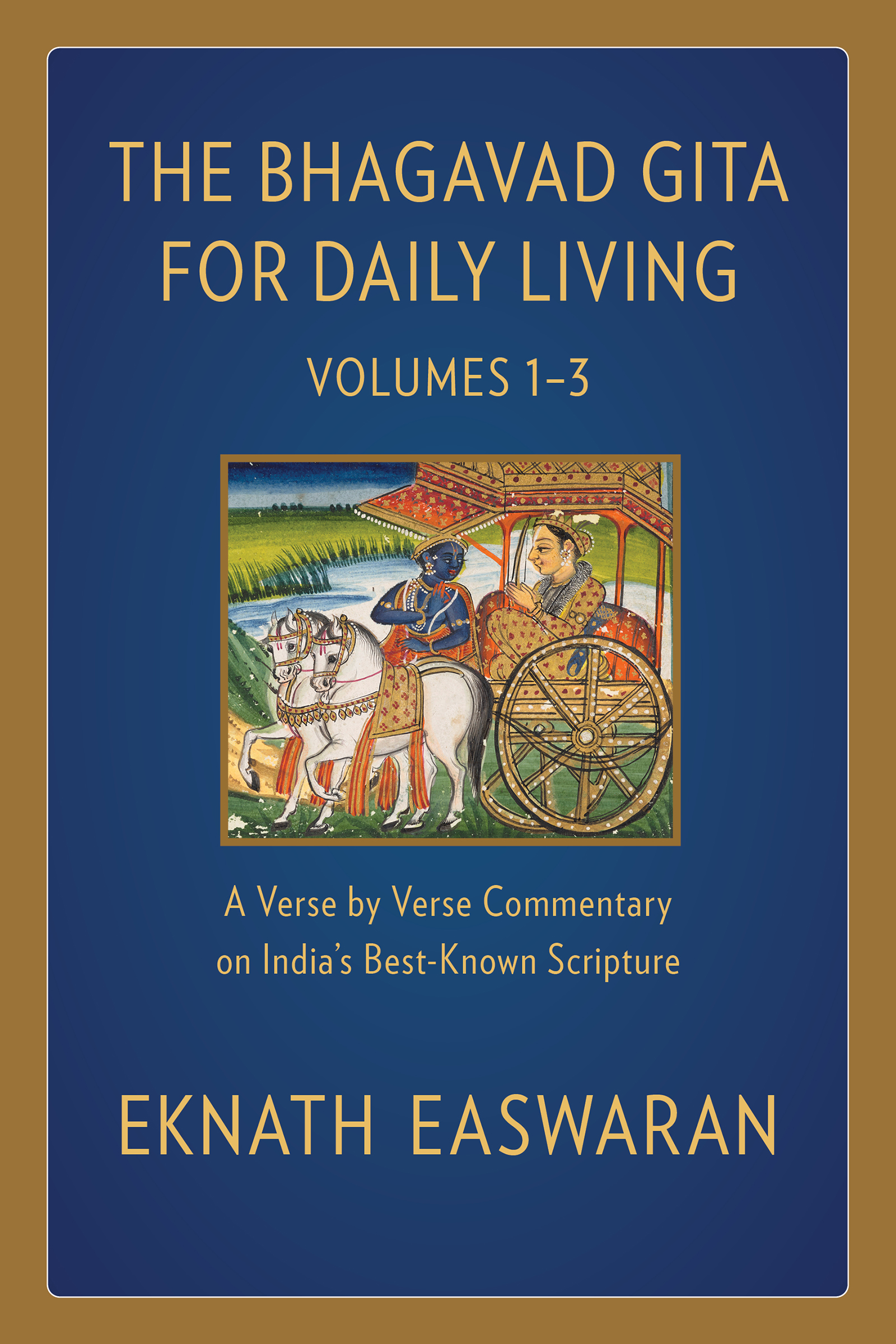
The Bhagavad Gita
for Daily Living
A Verse-by-Verse Commentary
Volumes 13:
The End of Sorrow
Like a Thousand Suns
To Love Is to Know Me
By Eknath Easwaran

1975, 2020 by The Blue Mountain Center of Meditation
All rights reserved.
First published 1975. Second edition 2020
10262020
Table of Contents
Foreword To The First Edition
A Living Tree
This practical commentary on the Bhagavad Gita, one of the greatest scriptures of the world, has grown out of the weekly talks given by Sri Eknath Easwaran to a group of his devoted students and friends in Berkeley. The talks, beginning in May 1968, have been carefully recorded and transcribed weekly with the help of many members of Easwarans ashram, or spiritual family. The transcribed lectures were then compiled and edited under Easwarans close su pervision.
The Gita class, like all of Easwarans classes, is primarily a preparation and inspiration for the practice of meditation as well as a commentary on a particular scripture. Group meditation follows the hour-long talk, in which Easwaran usually covers one or two verses from the Gita. In these impromptu talks, he may apply the verse to the biggest challenges facing the world today or direct his comments to solving the personal problem of a friend in the audience. But whether talking about local incidents in Berkeley or international issues, his unchanging purpose is to inspire his listeners to practice the Gita in their daily life and to make the Gita a driving force in their consciousness. The purpose of this book is to enable Easwarans readers, also, to translate the timeless values of the Gita into their daily living through the practice of m editation.
Easwaran began studying Sanskrit, the language of the ancient Hindu scriptures, at the age of ten in his village school in Kerala state, India. He also studied Sanskrit at his ancestral Shiva temple under a priest from a community which is well known in India for its pure Sanskrit tradition. Thoroughly familiar with the Gita in the original Sanskrit, Easwaran is also perfectly at home in English, though Malayalam is his mother tongue. In interpreting the scriptures, however, he relies on neither his Sanskrit nor his English scholarship, but on his experience in meditation and his personal practice of the spiritual life. He grew up in a large joint family in the matrilineal tradition of Kerala, and he considers his mothers mother, the flower of the Eknath family, his spiritua l teacher.
It is said that every spiritual teacher has a particular context in which he or she flourishes best. Easwaran is an educator. Formerly, he would say, it was education for scholarship, education for degrees; now it is education for living. Before he came to the United States he was chairman of the Department of English at the University of Nagpur and was devoted to his students and the literature he taught them. After coming to this country on the Fulbright exchange program in 1959, Easwaran began giving talks on meditation and the spiritual life, and the response was so great that in 1961 he established the Blue Mountain Center of Meditation in Berkeley to carry on his work of teaching meditation. Since that time, except for one return to India, he has been giving ongoing classes each week on the practice of meditation and commenting on the writings of the great mystics of all religions, including the Yoga Sutras of Patanjali, the Little Flowers of St. Francis, the writings of Meister Eckhart, the Upanishads, the Bhaktisutras of Narada, the Dhammapada of the Buddha, the Sermon on the Mount, Thomas a Kempiss Of the Imitation of Christ , and the Bhagavad Gita. He also teaches courses on meditation and on Mahatma Gandhi for the University of California Extension, Berkeley. In Nagpur, he likes to tell us laughingly, he had a reputation for always dragging Sri Ramakrishna into his lectures on Shakespeare and Shaw. Now, in these talks on the Gita, it is Shakespeare who illustrates the teachings of Sri Ramakrishna and St. Francis. The content has changed, but the context in which Easwaran flourishes cannot be very different: a small but extremely devoted group, perhaps eighty to a hundred, mostly young people of the sort who gravitate to a university town, gathered around in a semicircle to drink in the words of a man who is talking not about something he has read or something he has thought out, but about something he has experienced in his own life.
So this is a very special kind of book. Easwaran likes to say that it has grown like a tree because it issues directly from his life, which is so completely rooted in the Gita that every day he gains a deeper understanding of its teachings during even the most commonplace experiences: sharing ice cream with the ashram children in Santa Rosa, walking with friends down Telegraph Avenue in Berkeley, watching a mime with his wife in San Franciscos Union Square. Every Tuesday night in class this tree would flower, and we would hear these incidents retold as precise, profound illustrations of the Gitas applicability to our modern world. You can follow these incidents in this book, week by week, and at the same time you can trace the growth of the Blue Mountain Center of Meditation itself: the long months of looking for an ashram site, the building and remodeling when Ramagiri Ashram was acquired, the arrival of Easwarans mother and nieces from India. The result is a living document which, as Easwaran says, is still growing even now, and which will continue to grow as it is read and absorbed by others into their own lives.
Easwaran has chosen to comment on the eighteen chapters of the Gita in three volumes, each volume covering six chapters. It is said that these three parts of the Gita illustrate the profound truth of the Upanishads, Tat tvam asi: That thou art. The first six chapters are an exposition of tvam, thou, the Atman, and reveal the nature of our real, eternal Self. The second six chapters concern Tat, That: Brahman, the supreme Reality underlying all creation. The last six chapters explain asi, is, the relationship between tvam and Tat: the identity of the Self within and the supreme Reality, which unites all existence into one whole. The Gita develops this truth, That thou art, in practical terms: by discovering our real Self, we realize the indivisible unity of life and become united with the Divine Ground of existence.
Easwaran would like to convey his appreciation to everyone who has helped with this book, including those who have attended the Gita talks with sustained enthusiasm over the years. He wishes to express his deep love to all the members of his spiritual family who have assisted in translating, recording, transcribing, editing, and printing this commentary on the Gita.
In turn we, the editors, speaking for everyone who has helped, feel that working on this book has been a great privilege. Nachiketa, the student in the Katha Upanishad, tells Yama, A t eacher of this, another like you, is not to be found. No other boon is equal to this at all. The combination of enlightenment and practical, effective teaching in these pages is rare indeed, difficult to find in the mod ern world.
T he Editors
This second edition (2020) incorporates revisions made across all three volumes following the authors final instructions.
The Bhagavad Gita for Daily Living
Volume One
The End of Sorrow

Font size:
Interval:
Bookmark:
Similar books «The Bhagavad Gita for Daily Living Vols 1 to 3»
Look at similar books to The Bhagavad Gita for Daily Living Vols 1 to 3. We have selected literature similar in name and meaning in the hope of providing readers with more options to find new, interesting, not yet read works.
Discussion, reviews of the book The Bhagavad Gita for Daily Living Vols 1 to 3 and just readers' own opinions. Leave your comments, write what you think about the work, its meaning or the main characters. Specify what exactly you liked and what you didn't like, and why you think so.

